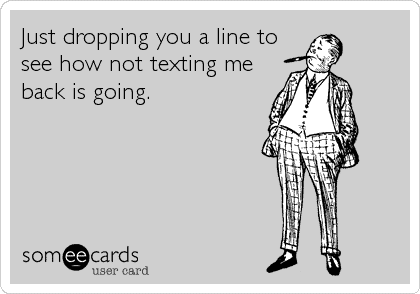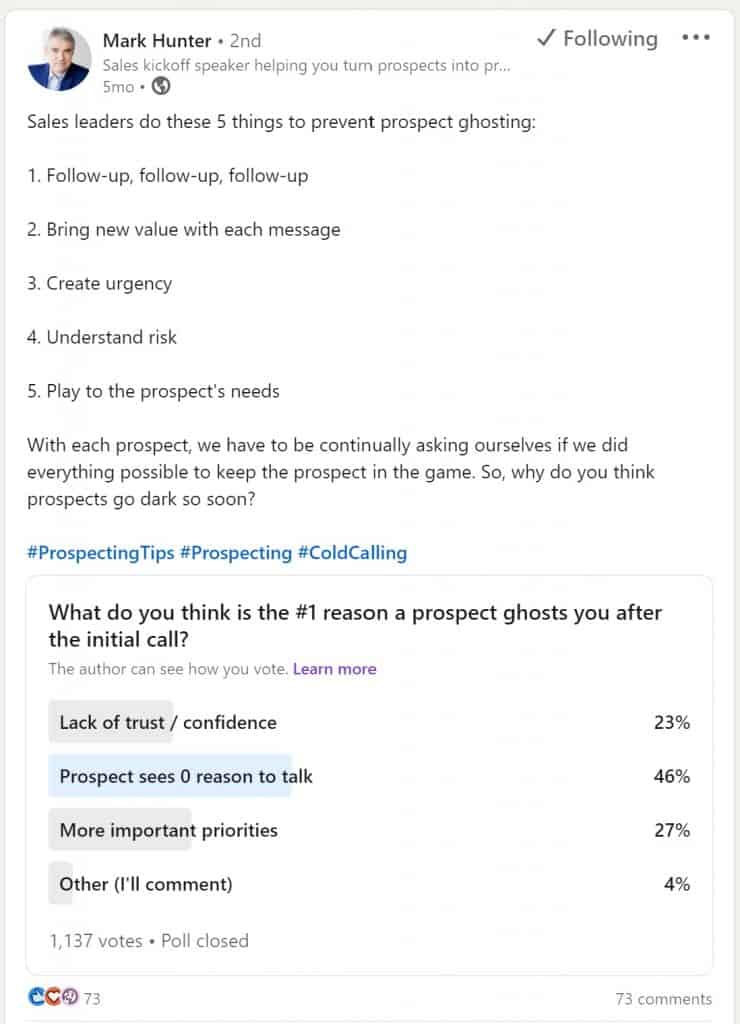Updated on February 20, 2024
Just like in dating, people sometimes disappear without explanation, even though you had a great conversation rolling… If somebody stops answering your messages out of a blue sky, it means they have ghosted you. It’s probably one of the worst feelings ever… But even though it’s not a very classy thing to do, professional neither, it happens! And most often than not, it has nothing to do with you. So don’t take it personally.
What does ghosting mean in business?
The term ghosting comes from the dating scenes, but sales people struggle with the same phenomena in the business world as well. I believe every business owner and sales professional can resonate with the following story of their sales career.
You had a great conversation going with one of your promising prospects. Exchanged emails, delivered your sales pitch, nailed your demo call, they openly expressed interest in your services, asked for additional info, you sent a detailed follow-up email, and then… nothing. *crickets singing*
Days and weeks have passed and your prospect is nowhere to be found. They are not answering your phone calls or replying to your emails… you’ve been ghosted.👻
And just like in any relationship, client ghosting is real, and it hurts.
It’s even worse when the prospect ghosts you just at the end of the sales process – after your last sales meeting and right before you were about to close on them.
You’re left confused as to why that happened? …and deeply disappointed.
Why do people ghost sales?
Client ghosting is another great challenge in sales and the reasons why prospects ghost you might be plenty and various. As I already mentioned earlier, most of the time the reasons are innocent and have little to do with you, personally. Here are the most common reasons why do people ghost sales.
#1. You misqualified your leads
All your leads and potential clients are at a different stage in the buying process. You might have engaged with a prospect early in their buying process, but treated them like they are ready to buy. This mistake can be avoided with a Lead Scoring model to direct you as to how you should approach each prospect on your list depending on which stage they are in the buying cycle. When you’re pushing your leads to move forward at your own pace due to a lack of lead qualification process you end up sending the sales pitch too soon which results in a silent treatment.
In need of a new Lead List?
Schedule a Call with our team and get a free Lead Sample for free.
#2. They’re looking for alternative solutions /or found a better deal
It would be naive to think that prospects wouldn’t consider looking for alternatives before buying.
77% of B2B clients perform a comprehensive ROI analysis before buying. And…
“Consumers make 12 searches on average before engaging on a specific brand’s site. B2B consumers are highly educated and like to comparison shop for the best possible value.”
Source: Google.
And while this is totally understandable, many prospects avoid telling you they are looking for other options to compare. This usually happens when they are in the consideration stage: researching and considering your competitors. They might be having discussions with some of them and cool you off.
That’s why it is important to segment your leads according to the stage in the sales cycle they’re currently in to avoid pushing them for a deal. Align your communication correctly and position yourself as the trusted source while you nurture their decision with high-quality content they care to receive.
Here’s some inspiration on lead nurturing campaigns.
#3. You might have lost your grip over the sales process
At some point in the sales process, you lost control over the sales negotiation, and let the potential client slip out of your hands.
“When I look back at a company that ghosted me on employee benefits, which is what we offer, it’s typically because I neglected to get an upfront verbal contract. We do not charge for consulting on a company’s employee benefits package but if we can lower costs, provide better service, or increase benefits at the same cost, I ask for a yes or a no.
In my upfront contract, I’ll typically say “If we can help you with this problem and we’re the best fit, what would stop you from using us? And if I can then overcome that obstacle would you please provide me the courtesy of a definitive Yes or No, as I will provide you the same.”
William Capece, JS Benefits Group
When you know you have the correct solution for your prospect, your job as a sales rep is to guide the prospective clients all the way from the initial conversation and point of contact to the signing of the contract. After all, the number 1 reason you are there is to help them realize that you have the solution to their pain points.
Leading the sales process involves providing the next steps you both should take. Is that to schedule a demo call, fill out a form, read an article, what do you want them to do next? And what should they do next depending on where they are currently? Even when you’re sending over your offer – set a deadline for the next meeting to take place to finish the sales discussion.
“One trick that I always use when I want to pressure a little is to mention that I have other projects in line and that I would like to schedule all of what I have to do. So I need their confirmation right away. Works every time.”
Edward Eugen, 10Beasts
This article might help you with your sales negotiations.
#4. Bad timing: your solution doesn’t fit their current needs
Although they might be very interested in your product, maybe their budget is tight right now and they can’t afford it. Or maybe what you’re selling just doesn’t work for them right now. Yes, your solution might help with their workflow, but at a later stage in their business growth & development.
Sometimes your sales pitch may be so captivating that they were engaged with your presentation and really liked your product leaving you expecting a positive response. But, behind the scenes, they have other more painful issues at hand to resolve first. And nobody likes to be the messenger of bad news, so the client may avoid indulging further with you, at least until they get to the point when they are ready to purchase.
“Using your solution may provide a benefit to the prospect. You may solve a business problem, but it’s possible that that problem isn’t the company’s top priority right now. Some people don’t like saying “no,” so they play for the sake of passing the time. You may have also interacted with a prospect early in their purchasing process. It’s possible that the acquisition process will take many months, so pressuring them to go at your pace isn’t the best choice. If you push your prospect too hard, you can get sporadic ghosting.
So, during your initial conversations, it’s usually a good idea to inquire about the purchase process/timeline. Another factor to consider is the budget. In terms of budget concerns, your timing might not be ideal. Many businesses aim to spend in the future year, and you may be budgeting too late or too early. Alternatively, given the current state of the economy, your clients’ budgets may alter, and their budget margins may be insufficient to purchase your services.”
Daniel Foley, SEO Manager @ MCS Rental Software
“There are times when I can get a meeting with a client, send a proposal after, but then the client or prospect just stops responding… which can be disheartening since I’ve spent a lot of effort on the proposal. However, we have to accept that this is just part of the business, and sometimes it’s something out of our control. Maybe they just don’t really need the product right now or maybe I just caught them at bad timing. From my experience, what I do is send them follow-ups and make sure that for each email, I add or emphasize the value of what I’m offering. Usually it takes about 5 or more follow-ups before a client responds again so I just persevere and nurture them with relevant information.
However, there also comes a point that I have to let go and just focus my effort on other prospects. When this happens, I make sure to self-assess and see where I could’ve done better so I always keep on improving.”
Sherry Morgan, Founder @ Petsolino
Here’s what we do in these circumstances, here at Sales.Rocks.
📚 Related Reads
📘 How to Follow-up with Sales Leads After Getting No Response?
📙 The Ultimate Guide to B2B Sales Triggers and How to Track Them
What to do when a prospect is ghosting you?👻
Tip #1. Create a welcoming environment for them to return to
“DO NOT go off on the prospect, no matter how badly you want to!
Don’t make things worse if anything went wrong during the early stage of the sales process. Instead, leave a message stating that you would want to check up on them. To turn the tables, ask questions. This will demonstrate that you are interested in resolving their issue. Then, in a subtle way, reclaim control by providing them with a few alternative time choices for reconnecting in the days ahead.
If your prospect contacts you again, set up a video call with them rather than an email or a conventional call. When you’re on the phone, ask questions to make them feel like they’re in charge. They feel more in control the more time they spend chatting. That’s a win-win situation for you! They not only feel better, but you’re obtaining the knowledge you need to assist them to solve their issue! Remember to use extra psychological sales methods like social evidence and expert proof, reciprocation, and testimonials.
Set up the next sales meeting as soon as you get the customer back in your hands!”
Anjelica Rivera, Sales & Marketing Director @ Cell Tracking Apps
Tip #2. Send personalized messages and ask specific questions
“Because they believe they are simply one of many prospects and are not a high priority, some prospects may not feel guilty about ghosting you.
Personalize your messages and ask specific questions to pique your prospect’s interest and generate a response. If you leave a message or send an email, tell your prospect how much you respect their business and then ask them specific questions. Follow-up that is consistent and well-thought-out will instill a sense of accountability in your prospect and, perhaps, result in a response. This is an example of a message you might wish to send to your prospect:
Take note of how this message creates a sense of urgency by seeking a response within a specified amount of time. This is also an excellent strategy to have in your back pocket.. Consider how you respond to messages in your daily life: you probably feel compelled to respond to urgent messages first. Requesting a quick response will almost certainly result in a higher response rate from ghosted prospects. Finally, you want to get a response immediately soon – even if it’s a “no” – since you don’t want to waste time trying to keep a prospect who may never respond. This time could be better spent attracting more attractive applicants.”
Gerrid Smith, CEO & Founder of Criminal Defense
Tip #3. Humor is the key: send a meme!

Mike Howard, 2JETSET
Chris Kille, founder of Payment Pilot
Erin Mastopietro, co-founder of Dope Dog

Tip #4. Remind your prospect of their desired outcome
When a prospect ghosts you, it’s critical to remind them why they were interested in the first place. Let them know you’re still available to deliver and that you’re looking forward to hearing from them. As a prospect progresses through the sales cycle, they may lose sight of what they were seeking in the first place. As a result, they may cease all communication since they have forgotten the value of what you have to offer. Reminding them of their early desires may rekindle their enthusiasm for your services. A sample message would look like this:
Reminding your prospects of their intended outcomes can help them reconsider how much they need what you have to offer. It’s acceptable if their requirements have been altered. However, you’ll benefit by inquiring whether the prospect’s needs haven’t changed because it will help you decide whether or not it’s worthwhile to follow the prospect further. Always remember to follow up with tailored and detailed messaging, and to remind your prospect of their initial goals. These strategies will help you decide if you should pursue the prospect or move on.
Ariana Flynn, Marketing and Communications Manager @ ProxyRack
Learn how to drive more sales



